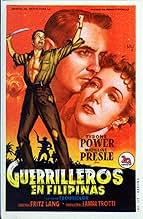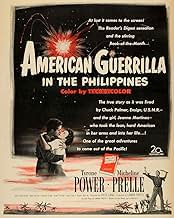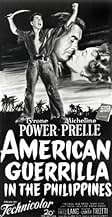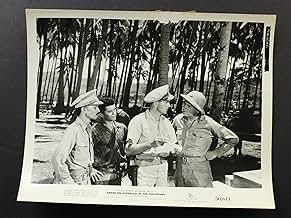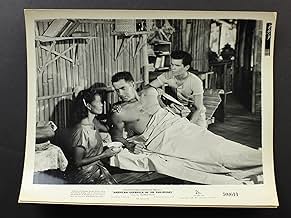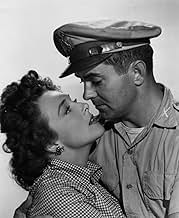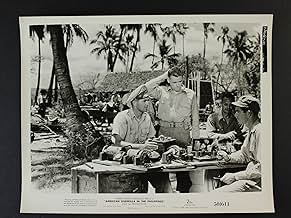IMDb रेटिंग
5.9/10
1.4 हज़ार
आपकी रेटिंग
अपनी भाषा में प्लॉट जोड़ेंAmerican soldiers stranded in the Philippines after the Japanese invasion form guerrilla bands to fight back.American soldiers stranded in the Philippines after the Japanese invasion form guerrilla bands to fight back.American soldiers stranded in the Philippines after the Japanese invasion form guerrilla bands to fight back.
Micheline Presle
- Jeanne Martinez
- (as Micheline Prelle)
Robert Patten
- Lovejoy
- (as Bob Patten)
Miguel Anzures
- Native Traitor
- (बिना क्रेडिट के)
Sabu Camacho
- Bo
- (बिना क्रेडिट के)
Erlinda Cortes
- Partisan
- (बिना क्रेडिट के)
Cris de Vera
- Japanese Officer
- (बिना क्रेडिट के)
Rosa Del Rosario
- Partisan
- (बिना क्रेडिट के)
Maria del Val
- Señora Martinez - the Aunt
- (बिना क्रेडिट के)
Vic Diaz
- Japanese General
- (बिना क्रेडिट के)
Arling Gonzales
- Radio Operator
- (बिना क्रेडिट के)
Fred Gonzales
- Radio Operator
- (बिना क्रेडिट के)
Eddie Infante
- Col. Dimalanta
- (बिना क्रेडिट के)
फ़ीचर्ड समीक्षाएं
It's not really about what I thought of the film - I note military and naval experts have commented on various inaccuracies. This is more a comment on an aspect of the film, which I saw many years ago in b/w, and got a greater insight into when seeing the Canadian commentator Elwy Yost's programmes on cinema history in the 1970's. How many viewers realise that the reason the heroine (the Filipino hero's wife) is cast as a Frenchwoman? This is not to make the story more romantic, or as a tribute to 'our gallant wartime allies' or even because the actress might be French, but because in those days to comply with the Hayes Code, the heroine, if she gets the white hero in the end (or vice versa!) has to be white!
9w0aq
I caught this movie on the Fox Movie Channel last week. A shame that the DVD is not available as this one would be a keeper. If you like WWII era movies this one is a good one. It documents insurgency activity against the Japanese during the war. A rag-tag group of people including some Americans separated from the rest of their detachment lead locals in a courageous and sometimes complex scheme to keep the enemy unaware of their activities.
This was an easy movie to get into and one I would add to my collection if available. It is in color as well and features some spectacular shots.
This was an easy movie to get into and one I would add to my collection if available. It is in color as well and features some spectacular shots.
This movie had a rush release just weeks before American soldiers get serious in Korea. A very good feel from this war drama about American fighters stranded in the Philippine Islands waiting for Gen. Douglas MacArthur's return. Guerrilla warfare helps sustain against the invading Japanese in 1942. Some very nice scenery and interesting war action. Top direction from Fritz Lang and potent acting from Tyrone Power and Tom Ewell.
This is a seldom referenced and very overlooked old movie, but Fritz Lang still shows what an amazing filmmaker he is here. The script is good (not great) but the direction and some surprisingly good acting turn this one into a real winner. Definitely worth watching.
Not a bad movie, really. Colorful, exotic locations, educational, some interesting combat scenes. But coming from the director of "Metropolis" and "M"?
It reminds me of an anecdote told by the psychologist who wrote "The Three Christs of Ypsilanti." That's a psychiatric hospital in Michigan. Three patients claimed to be Jesus Christ. The psychologist was watching a film with the one named Louie. Adlai Stevenson, then Governor of Illinois, appeared on the screen. "That's me," cried Louie, "I'm Adlai Stevenson." The psychologist replied, "I thought you were Jesus Christ." "I am," said Louie, "I'm Jesus Christ too -- but I've got to make a living."
Fritz Lang must have had some similar motive for making this rather routine war film. It has every cliché in the book. The romance thrown into the middle of the muddle. The cavalry riding to the rescue at the last possible moment. The acting of the principals is at par, but some of the bits are played by people who seem to have had no training in inducing a suspension of audience disbelief.
The best scene in the film has Tom Ewell (in an uncommonly dramatic part) trying to hide from the Japanese under a rotting log. His bare feet are on an ant hill and soon his skin is crawling with stinging ants while he bites his tongue and prays.
The best performance is given by the Japanese officer. He's great. Sinewy, dapper, ruthless, ironic. Speaking to Michelline Presle, who has been aiding the guerrillas -- "You rike Americans with WHITE FACES, like boiled pork." Marvelous line. (That bleached skin, like blue eyes, is an evolutionary anomaly confined to northwestern Europe.) The guy is fascinating to watch physically, in the way that Jack Palance is.
Minor error. Ty Power and Tom Ewell are reporting on the position and movements of two Japanese destroyers (actually, they look like Geary-class American ships). Power gives the info on the ships to Ewell next to him, who relays it by phone to a radio operator who encodes and transmits it. But the operator isn't sending information on the location of the ships. He keeps sending the word "news" over and over, interspersed with a couple of letter "b"s.
It is not, as I say, a bad movie. It's just done rather by the numbers. A far better job dealing with our defeat in the Phillipines was done by John Ford in "They Were Expendable." This film is worth watching as a description of the very real guerrilla movement that developed in the Islands after that initial defeat.
It reminds me of an anecdote told by the psychologist who wrote "The Three Christs of Ypsilanti." That's a psychiatric hospital in Michigan. Three patients claimed to be Jesus Christ. The psychologist was watching a film with the one named Louie. Adlai Stevenson, then Governor of Illinois, appeared on the screen. "That's me," cried Louie, "I'm Adlai Stevenson." The psychologist replied, "I thought you were Jesus Christ." "I am," said Louie, "I'm Jesus Christ too -- but I've got to make a living."
Fritz Lang must have had some similar motive for making this rather routine war film. It has every cliché in the book. The romance thrown into the middle of the muddle. The cavalry riding to the rescue at the last possible moment. The acting of the principals is at par, but some of the bits are played by people who seem to have had no training in inducing a suspension of audience disbelief.
The best scene in the film has Tom Ewell (in an uncommonly dramatic part) trying to hide from the Japanese under a rotting log. His bare feet are on an ant hill and soon his skin is crawling with stinging ants while he bites his tongue and prays.
The best performance is given by the Japanese officer. He's great. Sinewy, dapper, ruthless, ironic. Speaking to Michelline Presle, who has been aiding the guerrillas -- "You rike Americans with WHITE FACES, like boiled pork." Marvelous line. (That bleached skin, like blue eyes, is an evolutionary anomaly confined to northwestern Europe.) The guy is fascinating to watch physically, in the way that Jack Palance is.
Minor error. Ty Power and Tom Ewell are reporting on the position and movements of two Japanese destroyers (actually, they look like Geary-class American ships). Power gives the info on the ships to Ewell next to him, who relays it by phone to a radio operator who encodes and transmits it. But the operator isn't sending information on the location of the ships. He keeps sending the word "news" over and over, interspersed with a couple of letter "b"s.
It is not, as I say, a bad movie. It's just done rather by the numbers. A far better job dealing with our defeat in the Phillipines was done by John Ford in "They Were Expendable." This film is worth watching as a description of the very real guerrilla movement that developed in the Islands after that initial defeat.
क्या आपको पता है
- ट्रिवियाThis movie was filmed just prior to the outbreak of the Korean War in June of 1950, and used American warships to portray Japanese ships. One such ship, the U.S.S. Orleck (DD 886), exists to this day after serving in the Korean War, the Vietnam War and being sold for a while to the Turkish Navy, and is permanently docked in Lake Charles, LA, where it serves as a museum.
- गूफ़When setting the sail early in the movie, Power's character refers to a halyard as a sheet. No real sailor would make such an error.
- कनेक्शनEdited into All This and World War II (1976)
टॉप पसंद
रेटिंग देने के लिए साइन-इन करें और वैयक्तिकृत सुझावों के लिए वॉचलिस्ट करें
- How long is American Guerrilla in the Philippines?Alexa द्वारा संचालित
विवरण
- चलने की अवधि
- 1 घं 45 मि(105 min)
- पक्ष अनुपात
- 1.37 : 1
इस पेज में योगदान दें
किसी बदलाव का सुझाव दें या अनुपलब्ध कॉन्टेंट जोड़ें

